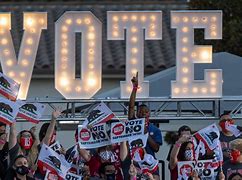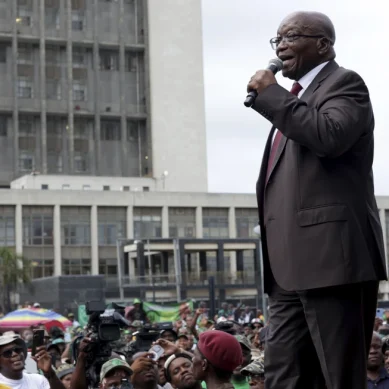
If pollsters were transparent, TargetSmart CEO Tom Bonier, a poll critic says, they’d share their “likely voter” models, and even release different scenarios based on different turnout assumptions.
“But pollsters are seen as gurus – they can’t be wrong. If they admit their polling is based on these ‘models,’ does that mean they don’t know what’s going on?”
Bonier, Democratic pollster Celinda Lake and other pollsters agree: The decisive “tell” that the poll was flawed was its finding that women are splitting their votes evenly between Republicans and Democrats.
“Do you really believe just months after losing a fundamental right, women will split their votes [between Republicans and Democrats]?” Bonier asks. “Have we ever since the ’90s had a situation where women didn’t vote more Democratic than men did?” pollster Anna Greenberg asked rhetorically in The New Republic.
Lake was more scathing, “There isn’t another poll in America that shows that,” she says. “If I did an outlier poll like that for a candidate, I’d have to do it over again at my own expense.” The Times should have tossed its October findings and started over, she says.
The best “polls” are of course actual elections, and Democrats have outperformed expectations in most of them this summer, thanks largely to increased turnout among women and young voters. In the special election for New York’s 19th Congressional District in August, there was a seven-point gender gap favouring Democrat Pat Ryan; Joe Biden’s edge among women in 2020 was only four and a half points.
“I’m not aware of a single poll in that race that predicted a seven-point gender gap,” Bonier says. Voter registration is surging among women and young voters, he adds. That doesn’t translate to turnout, however, pollsters are quick to admit. Without targeted intervention, many newly registered voters may not show up in November.
Still, Bonier notes, “one scenario that’s not too far-fetched is that post-Dobbs we’re going to see higher turnout among women and younger voters,” especially given those registration numbers. But most “likely voter” models won’t capture that.
Since all reputable pollsters warn not to take any one poll seriously, why are so many people focused on refuting this one? The main reason is the way the media hyped it. The storylines – Women shift to Republicans! The Dobbs effect is dead! – dominated cable news and many online and print news outlets on Monday and Tuesday.
“The danger is the extent to which the media takes a poll like this and turns it into a momentum narrative,” Bonier observes. “It doesn’t help [Democrats], not with fundraising. Can it dampen turnout? Potentially.”
One thing pollsters and advocates I talked to, as well as those canvassed by other curious journalists, agreed on: The Dobbs effect is not going away. But Democrats have to improve their messaging on the economy.
When Senator Bernie Sanders wrote in The Guardian that “Democrats shouldn’t focus solely on abortion. That’s a mistake,” he irritated a lot of feminists, including me. For one thing, he was setting up a straw woman: I’m not aware of one single candidate focused “solely” on abortion. “I think it bothered some of us because it seemed dismissive of how hard the movement has worked,” says Mini Timmeraju, president of NARAL Pro Choice America. But she doesn’t entirely disagree with Sanders.
“We do have to make a broader economic case,” she says. Also, given the history of the president’s party suffering midterm losses, she adds, “the headwinds are still pretty strong against us. This is a lot to put on the abortion movement.”
Lake, who polls for pro-choice groups and Democratic candidates, as well as nonpartisan organizations like the AARP, says Democrats have to make their economic message as strong as their abortion message.
“Why aren’t more people saying, ‘We capped insulin prices, we gave you hearing aids, we capped Medicare expenses, and Republicans will take all that away’?” the pollster asks. “Why aren’t they saying Republicans are promising to destroy Social Security and Medicare?”
The number-one group of swing voters, Lake says, “are women over 50, and these issues test off the charts with them.”
The younger segment, women 50 to 60, are particularly incensed – once they learn about the Republicans’ plans, that is, and Democrats are not doing a good job at that. The older women assume they’ll keep their benefits (although nobody really knows), while the younger women “know they don’t have time to establish an alternative to Social Security before they retire.”
Still, her polling has found that abortion matters to these older women, too. “Some remember when it was illegal. Endangering miscarriage care is also very salient to them,” the pollster says. “And they don’t like the idea of taking away rights from their daughters and granddaughters. ‘We’re going backward? That’s not the way things are supposed to work.’”
Timmeraju says she’s encouraged by what she’s seeing on the ground. The NARAL president has visited five states in nine days, “and the energy is incredible. Volunteers, canvassing – we’re seeing presidential-cycle enthusiasm.” And while Lake urges more robust economic messaging, she also insists that continued strong abortion messaging is crucial.
“Abortion is literally our best ‘get out the vote’ message – it’s how a lot of candidates will drive turnout. We need to see higher turnout by women and younger voters, and that’s a message that can help.”
Meanwhile, Timmeraju says she’s mostly ignoring polls at this point, less than three weeks before the election. “I am telling people on the ground they should not spend much time looking at the polls. Don’t freak out. Stay the course.” Words to live by for everyone at this point.











